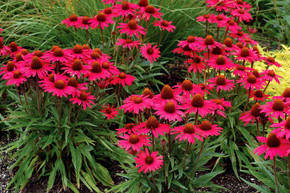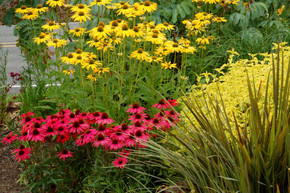

Please note your preferred ship date/week in the "Order Comments" section at checkout.
Otherwise, please allow 1-3 weeks to receive your order.
See the "Shipping" page under "Company Information" for our default ship dates based on hardiness zone.
We are unable to ship to any US Territories, AK, AZ, CA, CO, HI, ID, MT, NM, NV, OR, UT, WA, or WY
Wild form of Echinacea purpurea for the maximum wildlife support. It tolerates more shade than the cultivars, but also usually requires a bit more moisture.
So you can use it's advantage and plant in areas with some shade (especially in hot and dry position, it wilst easily or scorches the leaves). For very dry and hot spots rather use drought tolerant E. pallida, E. angustifolia, E. tennesseensis, E. paradoxa or E. simulata.
Easy to grow perennial for prairie style borders, conventional flower beds, public spaces and gardens, small private gardens, cottage gardens, rain gardens. The possibilities of use and combinations are nearly never ending.
Good companions can be Agastache, Aster, Asclepias (tuberosa, sullivantii, purpurascens), Baptisia, Eupatorium, Eryngium, Gaura, Helenium, Monarda, Phlox, Rudbeckia, Solidago, Veronicastrum, medium sized or tall native prairie grasses like Adropogon gerardii, Eragrostis spectabilis, Panicum virgatum, Schizachyrium scoparium, Sporobolus heterolepis, …
Unforgettable combinations paired with non-native perennials such as Eryngium, Echinops, hardy Geranium, Hemerocallis, Kniphophia, Origanum, Perovskia, grasses like Pennisetum,…
If you like annuals, combine it with single colored cultivars of Cleome, Cosmos, Zinnia or Verbena bonariensis or annual grasses like Pennisetum setaceum 'Rubrum' and others.
Blooming time : June/July to August/September
Size : 4' tall x 1.5' wide
USDA zones : 3 to 8/9
Culture: sun, half sun, half shade, dappled shade, average soil, clay, loam, rocky soil, drained soils. In comparison to hybrids, wild form tolerates less drought, but can be fairly happy with some shade during the day and here in Bloomington, IN (zone6), we can see it quite often on the edge of the woods, or even in dappled shade
Moisture Needs : medium-moist, medium, medium-dry, average drought tolerant - on fully exposed south facing and drier spots can scorch leaves, so for these areas it's better to use more drought tolerant E. pallida, E. angustifolia, E. tennesseensis other narrow-leaved coneflowers.
Origin: can be found in Eastern North America, native to moist prairies, meadows and open woods, woodland edges of the central to southeastern United States, see the USDA distribution map.
Deer/rabbit resistant : yes/yes
Attracts Butterflies or Pollinators : monarch plant and true pollinator magnet for native bees (long-tongued bees = bumblebees,digger bees, leaf-cutting bees), halictid bees, bee flies, honey bees. Magnet for many butterflies and skippers, who seek for the nectar - Monarchs, Fritillaries, Painted Ladies, Swallowtails, Sulfurs, and Whites. Caterpillars of the Silvery Checkerspot Butterfly feed on the foliage and several moths feed on the flowers.
Attracts Hummingbirds : yes. Attracts little song birds and goldfinch feed on the seeds.
Pot Size : 3.5" x 4" deep perennial pot
Picture copyright : US Perennials nursery
Wild form of Echinacea purpurea for the maximum wildlife support. It tolerates more shade than the cultivars, but also usually requires a bit more moisture.
So you can use it's advantage and plant in areas with some shade (especially in hot and dry position, it wilst easily or scorches the leaves). For very dry and hot spots rather use drought tolerant E. pallida, E. angustifolia, E. tennesseensis, E. paradoxa or E. simulata.
Easy to grow perennial for prairie style borders, conventional flower beds, public spaces and gardens, small private gardens, cottage gardens, rain gardens. The possibilities of use and combinations are nearly never ending.
Good companions can be Agastache, Aster, Asclepias (tuberosa, sullivantii, purpurascens), Baptisia, Eupatorium, Eryngium, Gaura, Helenium, Monarda, Phlox, Rudbeckia, Solidago, Veronicastrum, medium sized or tall native prairie grasses like Adropogon gerardii, Eragrostis spectabilis, Panicum virgatum, Schizachyrium scoparium, Sporobolus heterolepis, …
Unforgettable combinations paired with non-native perennials such as Eryngium, Echinops, hardy Geranium, Hemerocallis, Kniphophia, Origanum, Perovskia, grasses like Pennisetum,…
If you like annuals, combine it with single colored cultivars of Cleome, Cosmos, Zinnia or Verbena bonariensis or annual grasses like Pennisetum setaceum 'Rubrum' and others.
Blooming time : June/July to August/September
Size : 4' tall x 1.5' wide
USDA zones : 3 to 8/9
Culture: sun, half sun, half shade, dappled shade, average soil, clay, loam, rocky soil, drained soils. In comparison to hybrids, wild form tolerates less drought, but can be fairly happy with some shade during the day and here in Bloomington, IN (zone6), we can see it quite often on the edge of the woods, or even in dappled shade
Moisture Needs : medium-moist, medium, medium-dry, average drought tolerant - on fully exposed south facing and drier spots can scorch leaves, so for these areas it's better to use more drought tolerant E. pallida, E. angustifolia, E. tennesseensis other narrow-leaved coneflowers.
Origin: can be found in Eastern North America, native to moist prairies, meadows and open woods, woodland edges of the central to southeastern United States, see the USDA distribution map.
Deer/rabbit resistant : yes/yes
Attracts Butterflies or Pollinators : monarch plant and true pollinator magnet for native bees (long-tongued bees = bumblebees,digger bees, leaf-cutting bees), halictid bees, bee flies, honey bees. Magnet for many butterflies and skippers, who seek for the nectar - Monarchs, Fritillaries, Painted Ladies, Swallowtails, Sulfurs, and Whites. Caterpillars of the Silvery Checkerspot Butterfly feed on the foliage and several moths feed on the flowers.
Attracts Hummingbirds : yes. Attracts little song birds and goldfinch feed on the seeds.
Pot Size : 3.5" x 4" deep perennial pot
Picture copyright : US Perennials nursery
Healthy plants with excellent roots. Planted within two weeks upon arrival in spring and the plants are bursting with flowers. Each plant has 5 or more flowers and the plants are almost at full height. Pretty incredible for first year planting out of the original pot size. I'm looking forward to next year to see how much the plants grow wide. Thank you US preannials for growing and sending quality plants
